In a distributed system, testing the successful integration between
distributed services is essential for ensuring that the services
won’t fail in production just because they’re not speaking the same language.
This article discusses three approaches to implementing integration tests
between distributed services and shows the advantages of
Consumer-Driven Contract tests.
Strategies for Integration Testing
This article compares three testing strategies that can be used to implement integration tests and then goes into describing how those strategies work with some usual testing issues.
Before we go into the details of those testing strategies, I want to define the meaning of “integration test” in the context of this article:
An integration test is a test between an API provider and an API consumer that asserts that the provider returns expected responses for a set of pre-defined requests by the consumer. The set of pre-defined requests and expected responses is called a contract.
Thus, with an integration test, we want to assert that consumer and provider are speaking the same languange and that they understand each other syntactically by checking that they both follow the rules of a mutual contract.
End-to-End Tests
The most natural approach to testing interfaces between provider and consumer is end-to-end testing. In end-to-end tests (E2E tests), real servers or containers are set up so that provider and consumer (and all other services they require as dependencies, such as databases) are available in a production-like runtime environment.
To execute our integration tests, the consumer is usually triggered by providing certain input in the user interface. The consumer then calls the provider and the test asserts (again in the UI) if the results meet the expectations defined in the contract.
Mocking
In a mock test, we no longer set up a whole runtime environment, but run isolated tests between the consumer and a mock provider and between a mock consumer and the real provider.
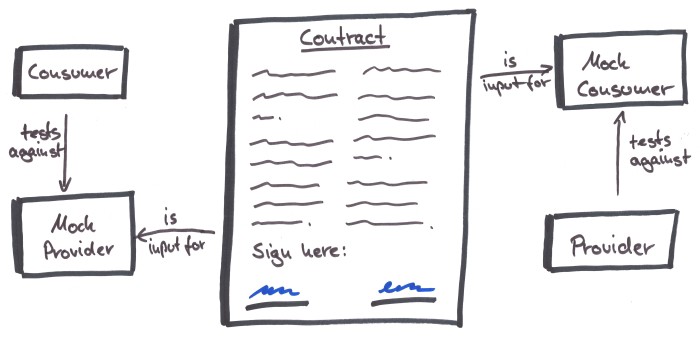
We now have two sets of tests instead of one. The first set of tests is between the consumer and a provider mock.The consumer service is started up and triggered so that it sends some requests to a provider mock. The provider mock checks if the requests are listed in the contract and reports an error otherwise.
In the second set of tests a mock consumer is given the requests from the contract and simply sends them against the provider service. The mock consumer then checks if the providers' responses meet the expectations defined in the contract.
Consumer-Driven Contract Tests
Consumer-Driven Contract tests (CDC tests) are a specialization of mock tests as described above. They work just like mock tests with the specialty that the interface contract is driven by the consumer and not, as one would expect naturally, by the provider. This provides some interesting advantages we will come to later in this article.
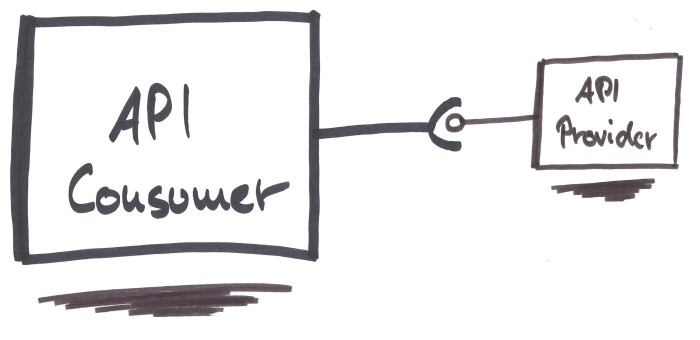
Comparing the Integration Testing Strategies
Let’s have a look at certain issues in testing and check how the testing strategies deal with them.
Isolation
We’ve all been taught that isolation in tests is a good thing. This is highlighted in the famous testing pyramid (see image below). The base of the pyramid consists of isolated tests (you can also call them unit tests, if you like). Thus, your test suite should consist of a high number of isolated tests followed by few integration tests and even fewer end-to-end tests. The reason for this is simple: isolated tests are easy to execute and their results are easy to interpret, thus we should rely on them as long as it’s possible.

E2E tests obviously aren’t isolated tests since each test potentially calls a whole lot of services. While I wouldn’t call mock tests and CDC tests “isolated”, they are definitely more isolated than E2E tests since each test only tests a single service: either the provider or the consumer.
Using mock tests instead of E2E tests for testing interfaces between distributed services moves those tests from the top of the testing pyramid at least one level down, so the point for isolation definitely goes to mock tests and CDC tests.
Testing Data Semantics
The correct semantics of data exchanged over an interface are, naturally, important for the data to be processed correctly. However, mock tests usually only check the syntax of the data, e.g. if a credit card number is syntactically correct but not if a credit card with that number actually exists.
The semantics of data can best be tested with E2E tests, since here we have a full runtime environment including the business logic that can check if the credit card actually exists.
Reducing the test focus from semantics to syntax should be a conscious choice you make when implementing mock tests. You are no longer testing the business logic but you are concentrating your test efforts on the potentially fragile interface structure (while covering your business logic with a separate set of isolated tests, I hope).
Complexity
For an E2E runtime environment, you have to deploy containers running your services, their databases and any other dependencies they might have, each in a specified versions (see image below).
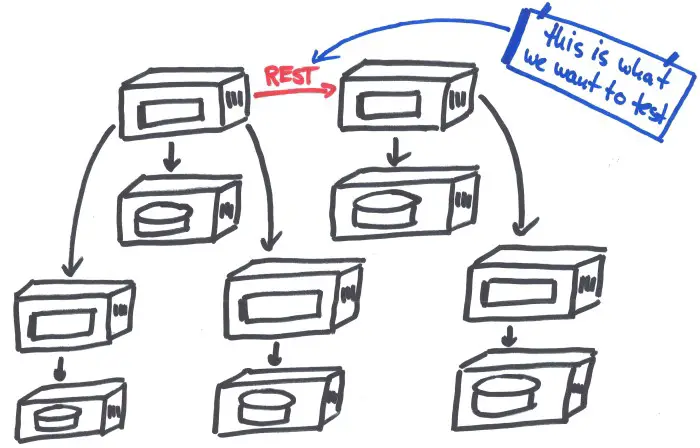
Nowadays, tools like Docker and kubernetes make this a lot easier than it was when services were hosted on bare metal. However, you have to implement an automatism that executes this deployment when the tests are to be run. You do not have this kind of complexity with mock tests.
Test Data Setup
Test data is always an issue when implementing tests of any sort. In E2E tests test data is especially troublesome since you have potentially many services each with their own database (see image in the previous section). To set up a test environment for those E2E tests you have to provide each of those databases with test data that match the expectations of your tests.
If cross-references between databases exist, the data in each database has to match the data in the other databases to enable valid testing scenarios across multiple services. Beyond that, you have to implement a potentially complex automation to fire up your databases in a defined state.
In mock tests, on the other hand, you can define the data to be sent / returned directly in the consumer and provider mocks without having to setup any database at all.
Feedback Time
Another important issue in testing is the time it takes from starting your tests until you get the results and can act on them by fixing a bug or modifying a test. The shorter this feedback time, the more productive you can be.
Due to their integrative nature, E2E tests usually have a rather long feedback time. One cause for this is the time it takes to set up a complete E2E runtime environment. The other cause is that once you have set up that environment you probably won’t just run a single test but rather a complete suite of tests, which tends to take some time.
Mock tests have a much shorter feedback cycle, since you can run them any time, especially from a developer machine and get feedback rather quickly (not as quickly as for usual unit tests, but quicker than for E2E tests for sure).
Stability
Due to the complexity, potentially erroneous test data and a whole lot of other potential factors, E2E tests may fail. If an E2E test fails, it does not necessarily mean that you found a bug in the code or in the test. It may mean that the runtime environment was badly configured and a service could not be reached or that a certain service was deployed in the wrong version or any other reason. That means that E2E tests are inherently less stable than tests that are better isolated like mock tests.
Unstable tests lead to dangerous mindsets like “A couple tests failed, but 90% successfull tests are OK, so let’s deploy to production.”.
Also, when setting up an E2E runtime environment, some of the deployed services may be developed by another team or even completely outside of your organization. You probably don’t have a lot of influence on those services. If one of those services fails, it may be a cause for a failing test and adds to the potential instability.
Reveal Unused Interfaces
Usually, an API is defined by the API provider. Consumers then may choose which operations of the API they want to use and which not. Thus, the provider does not really know which operations of its API are used by which consumer. This may lead to a situation where an operation of the API is not used by any consumer.
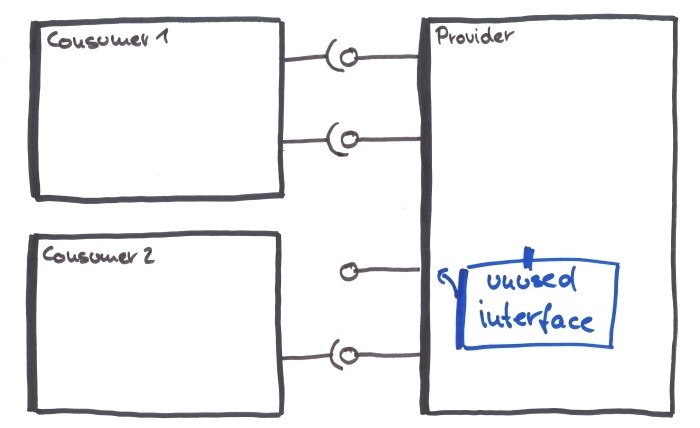
We obviously want to find out which operations of an API are not used so that we can throw away unneeded code cluttering our codebase. Running E2E tests or even plain mock tests, however, you cannot easily find out which operations of an API are not used.
When using CDC tests, on the other hand, if a consumer decides that a certain API operation is no longer needed, it removes that operation from the consumer tests and thus from the contract. This leads to a failing provider test and you will automatically be notified by your CI when an API operation is no longer needed and you can act accordingly.
Well-Fittedness
A very similar issue is the issue of well-fittedness of the API operations for a certain consumer. If a provider dictates an API contract, it may not fit certain use cases of certain consumers optimally. If the consumer defines the contract, it may be defined to fit its use case better.
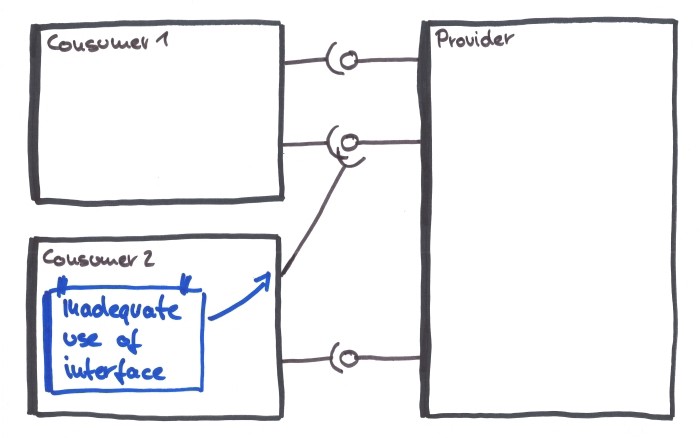
With E2E tests and plain provider-dicated mock tests, the consumer has no real say in matters of well-fittedness. Only consumer-driven contracts allow the consumer to match the API to his needs.
Unknown Consumers
Some APIs are public or semi-public and thus developed for an unknown group of consumers. In a setting like this, CDC tests obviously don’t work, since unknown consumers cannot define a contract.
Simple mock tests still work though. Instead of two sets of tests (one for testing the provider and one for testing each consumer) you only have one set of tests for testing the provider, since there are no known consumers to test. You just create a mock consumer that represents all the unknown consumers out there to test the provider.
“Real” E2E test are also not possible with unknown consumers since you cannot test end to end without a consumer. However, you could argue that it’s still an E2E test in the context of your application if you setup your provider in an E2E runtime environment and hit it with mocked requests from your contract.
Feature Overview
Here’s an overview table of the features of the different testing strategies discussed above.
| E2E Tests | Mock Tests | CDC Tests | |
|---|---|---|---|
| Isolation | |||
| Complexity | |||
| Test Data Setup | |||
| Testing Data Semantics | |||
| Feedback Time | |||
| Stability | |||
| Reveal Unused Interfaces | |||
| Well-Fittedness | |||
| Unknown Consumers |
As you can see, there are good reasons to implement Consumer-Driven Contract tests to test interfaces between services in a distributed system like a microservice architecture. If you are interested in implementing CDC tests, have a look at the Pact framework or at Spring Cloud Contract. For an example on how to use Pact, have a look at this blog post.



